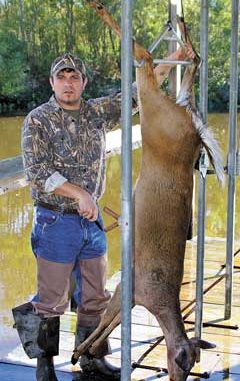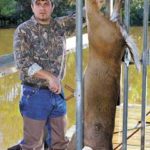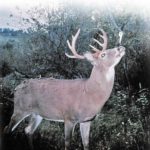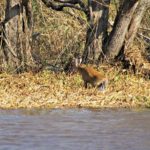
There are reasons deer activity is more pronounced at dawn and dusk.
4:05 p.m. — I down the last sip of my coffee. In no hurry, I notice my brother is getting antsy. Who wouldn’t? After traveling 1,200 miles from Michigan to duck hunt and possibly shoot his first deer, I could feel his emotions by his body language. When someone’s foot flips up and down nervously in the air, there usually is a root problem.
4:10 p.m. — I tell father-in-law I’ll be back shortly. Leaving Pop’s wharf, with brother in tow, we head down the bayou for a 10-minute boat ride.
4:20 p.m. — Anxious brother and I walk the marsh and get settled into one of my deer stands. I lean over and whisper to him, “In about 20 minutes after things settle down look toward the back in that line of willow trees, and you’ll see deer.”
4:30 p.m. — I pull my pocket knife and apple from my pocket, and start slicing bites.
4:38 p.m. — Like clockwork, my brother taps me and mouths quietly, while using his two fingers pointing at his eyes first then away from him toward what he was looking at. “I see deer!”
I smile, nodding to him with a cheek full of apple and sort of mouth “shoot,” while doing a little sign language of my own pretending to squeeze a trigger at the same time.
4:42 p.m. — As the report from my brother’s shotgun settles across the marsh, I see deer running everywhere, except the doe at which he was aiming.
5:15 p.m. — The high-pitched whine from my outboard has me in a zone as I wind my way toward home at 4,200 RPMs. Suddenly, my brother motions for me to stop.
“I didn’t believe you,” he says. “You kept telling me you were seeing deer every evening at the same time, and I didn’t believe you!”
If you hunt deer long enough, you’ll come to realize there is a handful of minutes in the stand that are “must” minutes when you’d better be sitting. Since most of those minutes are on the downward side of autumn equinox, they become fewer and fewer the closer to Christmas you get.
That handful of minutes can be found both in the morning and late afternoon. And if you’ve done your homework, finding success during those moments can be almost guaranteed.
Quite a number of years ago, I discovered those magic moments by accident more than anything after making several afternoon hunts in a row. By looking at my watch when I first spotted deer — or, as people refer to it in the South, when deer “came out” — I noticed the sun was dangerously close to setting and twilight was falling over the marsh, giving me about 15 minutes — perhaps 20 — to work with.
Through the long shadows, I strained to see. By the hands of my watch, I seemed to always be running out of time. The fastest 15 minutes in the world are morning and afternoon break time at work, the few moments after hitting the snooze on an alarm clock and when deer come out just before dark.
During those few days, the deer seemingly punched a time clock for both first and second shifts. I, on the other hand, seemed to be two hours early showing up for work; it became so routine I almost ruined my oldest son.
When his Paw Paw found him on the steps of the back porch when he woke up at 7 a.m. to let the dog out, he said, “Hey boy, what you doing here? I thought you and your dad were hunting deer this morning.”
“We are,” he replied. “They just aren’t moving this morning.”
My son was the recipient of having just enough success during those critical moments that his judgment became impaired. The way he figured it, why sit for hours and wait for deer? If it isn’t happening during those twilight periods, you might as well go eat breakfast and drink coffee.
The fact is, not all deer are harvested during those sweet moments. What’s more, when the rut is on and pressure as it relates to hunting increases, all bets are off to patterning any time period.
Nonetheless, deer are specifically impacted by sunlight when it comes to their behavior.
“Deer are crepuscular, which means they’re more active at dawn and dusk,” said Kip Adams, biologist for the Quality Deer Management Association. “Part of it plays into their eyesight in that they’re not color blind, but perceive it differently than we do. They are extremely good at seeing color in the blue wavelength.
“What that means is they see well in low-light conditions, much better than other things out there. So that’s one of the reasons they prefer to be more active at dawn and then again later at dusk. From an eyesight perspective, they have a real unfair advantage, because we don’t see well in either of those situations.”
Adams points out that unpressured deer will move more during the day than when they are being pressured. Additionally, pressure and not behavior forces them to also become nocturnal.
“Deer are neither diurnal nor nocturnal,” Adams said. “When they are not active during the day, it is a learned response. They say, ‘I smell unfamiliar odors in the area,’ or they just know something is different.
“We also cause them to move during the nocturnal period. We can make deer be a lot more active during these times because of our actions. They will move more during the night if humans or other predators pressure them, but mostly when pressured by humans. We turn deer nocturnal, so to speak.”
Louisiana deer hunters hunt everything from private leases with low memberships to clubs with high memberships and public lands that can be inundated with people at given times. Since deer mainly feed during the dawn and dusk periods, the varying level of pressure plays a huge part in a hunter’s success as he sits, perhaps, over a food plot or cowpea patch in the marsh, according to Louisiana Department of Wildlife and Fisheries biologist Scott Durham.
“Deer are early daylight and evening feeders,” he said. “Those are, basically, their normal feeding times. If not pressured — if not stressed by other things — mornings and evenings are their primary feeding periods. Feeding habit change is often more directly because of hunting pressure and just people all of a sudden riding around on four-wheelers.”
Hunters would do well to understand the importance of crepuscular habits of deer activity by minimizing pressure through changing tactics and limiting their presence.
There is no doubt the invention of the combustion engine has helped hunters put venison in the freezer. But as deer have adapted to modern machinery by going nocturnal, leaving their crepuscular norms, hunters might opt to walk or paddle a boat the last few hundred yards in the dark to reduce noise.
One hunter in our lease patterned a big buck’s behavior last season. By chance, he saw the big 8-point from a distance sneaking away in the twilight when another hunter approached a canal bank in his outboard. The canal bank also happened to be where he had another stand that he often hunted without success.
He realized the deer had patterned him. By walking across the marsh from a different direction and using a pirogue to negotiate a little bayou, he was able to sneak into his stand undetected. The 8-point was harvested during the crepuscular period when deer are most actively feeding.
Four-wheelers can also have the same impact as outboards on deer as the season progresses. Hunters should try motoring close to their stands, but plan to walk the last couple hundred yards quietly. Hunters would do well using a quality cover-scent or Scent-Lok clothing. The use of these stealthier tactics may be a slight inconvenience, but they just may put more deer sausage on the grill.
Hunters should also try and not sit in the same stand several days in a row. By changing it up, deer will feel less pressure during those few moments when they are most active in the morning and evening.
Lastly, if and when possible, hunters should try and get a few weekday hunts in throughout the season. Deer know when armies of hunters enter the woods for the weekend. During the week, you could possibly have the lease or WMA to yourself.
It’s also important to point out that deer don’t always feed during nocturnal periods just because of hunting pressure. Due to the warm subtropical climate we have in Louisiana, deer will often feed at night simply because of heat and the stress of moving around when temperatures are in the high 80s.
During the early part of October, it is not uncommon for archery and primitive weapon hunters to not see any movement from deer. Trail cameras might show a nocturnal pattern, but that doesn’t necessarily mean it will stay that way once a few cold fronts pass through.
In coastal areas, deer feeding heavily at night can be a result of hunting pressure, but in some cases, it’s merely a reaction to the heat. Night is simply the coolest part of the day.
“They’re not going to be up in the middle of a hot day if they don’t have to be,” Durham said. “Area 3 and 7 hunters have to often face extremely warm temperatures as their seasons are the first to open.”
7:00 p.m. — Deer is quartered and on ice, brother is now a believer, and a glass of merlot is on tap to toast another successful hunt in the twilight’s glow.






